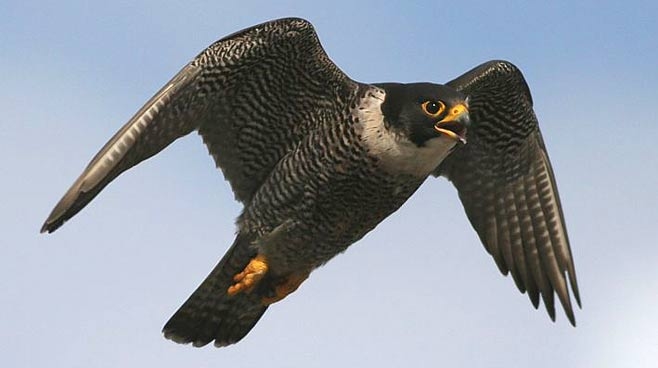Peregrine falcon - Falco peregrinus
Swerfvalk [Afrikaans]
uHeshe [Zulu]

Peregrine falcon
Distribution and habitat
It can be found in every continent of the world excluding Antarctica, with some sub-species that are resident and with others that are migratory. Most of the sub-Saharan Africa population is resident, absent from the equatorial lowland forest of West Africa. In southern Africa it is generally uncommon and localised in Namibia, northern and eastern Botswana, Zimbabwe, western Mozambique and South Africa. It generally favours riverine, mountainous or coastal environments, especially with high cliffs, used for roosting and hunting. Dam walls, quarries and the tall buildings of city centres can also fulfil this purpose.
Movements and migrations
Most of the southern African population (the subspecies Falco peregrinus minor) is resident and sedentary, however the migrant Falco peregrinus calidus may also be present in the region in the period from October-March, and can often be found in more open habitats than its resident counterpart.
Food
It eats mainly birds, supplemented with bats and flying insects, catching all of its prey aerially. It does most of its hunting in the vicinity of a cliff or another tall structure, either hunting from a perch near the top or from high up in the air, so that it can single out an individual; once it has done so it dives almost vertically and, due to its aerodynamic shape, can attain speeds of over 300km/hr!
It strikes its prey with its talons at this speed (killing it instantly), or if it misses it may give pursuit for over two kilometres before returning to a perch to feed, if the hunt was successful. It sometimes flies close to the cliff face to flush birds and then chase them, and it may even rob the nests of cliff-nesting birds.
On the whole about a quarter of its hunts are successful, based on two different South African studies.
Breeding
Monogamous solitary nester, with pairs sometimes remaining together for as long as 11 years, both performing spectacular aerial displays in the run-up to the breeding season.
The nest is typically a simple scrape in a sheltered ledge or cavity in a cliff or quarry face; it may alternatively use a stick nest on a cliff of another bird, such a Verreaux's eagle or White-necked raven.
Egg-laying season is from late July to early November.
It lays 1-4 eggs, which are mainly incubated by the female for about 32-36 days, while the male occasionally incubates in the day but is mostly focused on providing the female with food.
The chicks are brooded constantly by the female for the first few days, after which she only broods intermittently, stopping completely when they become about 10-15 days old. The young are fed mainly by the male so that the female can care for them and defend the nest; they take first flight at approximately 42-46 days old, only becoming fully independent roughly 1-3 months later.
Threats
Not threatened globally but Near-threatened in South Africa, probably due to a combination of persecution in city centres, susceptibility to agrochemicals, nest site disturbance, deforestation and river impoundment.
The Cache

The cache is a small lock 'n lock container in a camo bag.
